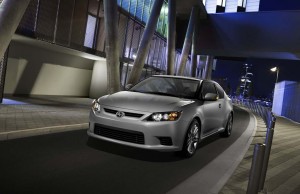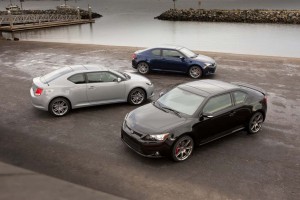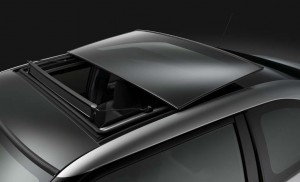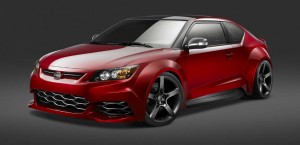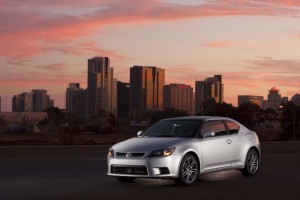“Turn it up LOUD,” suggested Jack Hollis, the general manager of Toyota’s youthful Scion brand, as we headed off for our first drive in the new 2011 tC coupe.
The most popular car in the Scion brand, accounting for over 40% of its overall sales, the tC also happens to be the most youthful car on the market, attracting a buyer who is, on average, just 26 years old. For them, a high-watt sound system is as important as a high-power engine and low 0 to 60 times in judging the appeal of the 2011 Scion tC.
That’s not to say performance doesn’t matter. Or styling. And the Toyota division took aim at all these attributes when they developed the second-generation Scion tC coupe, which is just now rolling into U.S. dealer showrooms.
For those who’ve somehow missed out on Scion, think of it as a brand-within-a-brand, a nameplate aimed at those young – and largely first-time — new car buyers who wouldn’t be caught in the Toyotas their Baby Boomer parents have been driving. Scion has made an intriguing business case for itself by rolling out a procession of small, hip and affordable products that it markets in very millennial fashion. Skip the TV and print ads, for the most part, and focus on social marketing, with events like the one in Los Angeles, recently, that drew more than 10,000 Scion owners and their friends.
Maybe we’re out of touch, but we wanted to see what it was like to actually drive the new tC, rather than judge its merits based on one of the cool online projects the brand has launched.
Edgy styling has been a hallmark of the Scion marque since its debut, seven years ago. Think of the boxy xB. The original, curvaceous tC coupe, meanwhile, has evolved into a much more edgy shape that was notably developed by Toyota’s advanced design studio, CALTY, in Southern California.
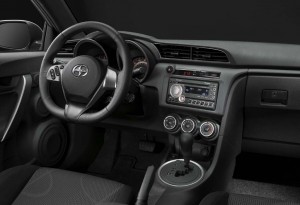
The new tC's interior is a bit larger and better finished - with the exception of a center console cover that feels like it could readily break off.
It may appeal to younger buyers but to our eyes it was a bit of a design mish-mash, with a sort of sports car roof line (here think Nissan GT-R) paired with a high-line model’s sweeping C-pillar. The look of the 2011 Scion tC is distinctive but clearly polarizing.
(No hybrids or battery cars for hybrid. Click Here for the story.)
Describing the cabin, Hollis asked us if we could come up with the usual list of attributes industry executives use to describe a new model. Bigger, more lavish, more elegant. Regular review readers know the terms by heart. The reality is that they do seem to apply here. The 2011 Scion tC interior is bigger – with an extra inch of width for each front seat occupant, for example. The seating is more comfortable but also more supportive during aggressive driving.
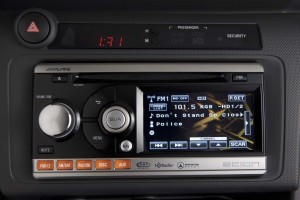
You'd be better off texting than trying to read the tiny navi screen on this Alpine system while driving.
The instrument panel retains the distinctive rice paper graining of the original tC, and the overall look is more refined, particularly when it comes to the twin gauges. The one harsh misfit? The Alpine audio head unit that looks like it was plugged in to fill an empty space. The reality is that even the base sound system – at 300 watts, with 8 speakers – should satisfy most young, music-crazy buyers. But visually, the Alpine doesn’t work.
Nor does its built-in iPod Nano-sized LCD navigation screen. Forget texting while driving. Try to make sense of the display and you’ll be rear-ending the car in front. Worse, it simply doesn’t provide much detail. Zooming in and out we couldn’t get it to show Rochester Road, a main thoroughfare that was part of our test drive route.
Barring those modest complaints, there’s not much to dislike about the 2011 Scion tC.
The new coupe comes with a peppy little 2.5-liter Inline-four that makes 180 horsepower and 173 lb-ft of torque. That’s up 19 hp and 11 lb-ft from the smaller engine in the 2010 tC.
Scion has traditionally offered only the most basic factory options and the new coupe is no exception. You can pick your color and your gearbox, either a 6-speed automatic or 6-speed manual. The former will get you from 0 to 60 in 8.3 seconds, the stick in 7.6. Both deliver identical fuel economy numbers: 23 mpg City, 31 Highway.
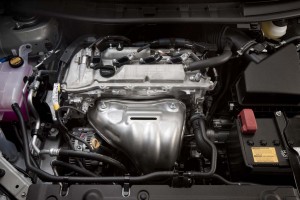
Peppy but just middle-of-the-road on mileage, the new tC gets a larger, more powerful 2.5-liter engine.
Those aren’t especially impressive. The new Ford Fiesta, with an admittedly smaller engine, gets you 28/37. The 2010 Honda Civic will push into the 25-26 mpg range, City, and into the mid-30s for Highway, except for the sportiest, and more fuel-hungry, Si trim.
The 2011 Scion tC features an upgraded chassis with a beefed-up suspension, with McPherson struts up front and a double-wishbone rear. The new model has meanwhile migrated to an electric power-assist steering system.
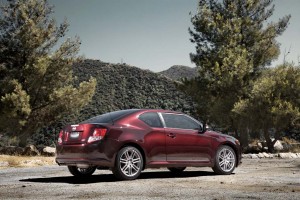
Like all Scion models, the tC has a distinctive design, with the high-line curve to the C-pillar one of its signature features.
While we were initially averse to EPAS, the tC is among the many new models that show that electric-assist steering can do a reasonable job of matching up to conventional hydraulic systems. While our test route had only limited opportunities to flog the Scion coupe through the curves we were generally impressed by its good on-center feel and responsiveness. The suspension, meanwhile, was well planted and predictable.
One nice move was the upgrading of the tC’s brakes. Those larger discs are barely concealed by the now-standard 18-inch alloy wheels. Another nice new feature is the tilt/telescope steering wheel. The old model only offered tilt.
While Scion has opted for limiting customer choice – from the factory – it isn’t a one-size-fits-all brand. Far from it. The Toyota division does, in fact, encourage more customization than perhaps any other marque but Mini. The key here is that you get the upgrades at the dealer, or order them and do it yourself. The list is seemingly endless, which such options as a rear spoiler, three different audio head units, carbon fiber B-pillar, body graphics and an assortment of performance parts from Toyota sports arm, TRD, such as 19-inch wheels, beefed-up exhaust and a short-throw manual shifter.
One part not yet formally on the list is a supercharger. “Not definite,” responded Hollis, when asked if it is coming. Our bet is that it will eventually make the list, though not until late in the coming model-year, at the earliest.
Depending on how much customization you have in mind you could spend a small fortune – at least for a 26-year-old buyer – but getting into the base 2011 Scion tC isn’t especially expensive. With the stick, it’ll set you back $18,275. Add another $1,000 with the automatic.
Is it worth the money? If you’re a young buyer looking for something distinctive and sporty, with reasonable acceleration, okay mileage, a lot of boom from the audio box and endless opportunities to customize, then the 2011 Scion tC is a good place to begin your search. But there are a growing number of alternatives to consider, so Scion will need to amp up its effective viral marketing program in the years ahead.

